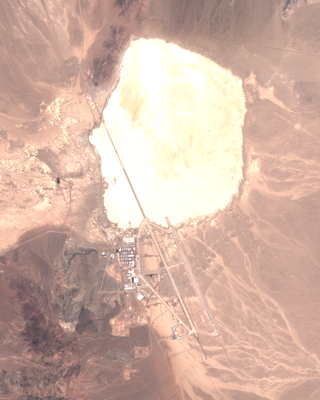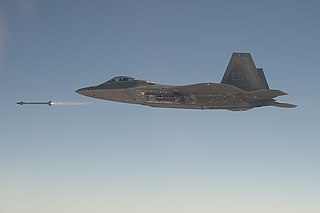
Area 51 is the common name of a highly classified United States Air Force (USAF) facility within the Nevada Test and Training Range. A remote detachment administered by Edwards Air Force Base, the facility is officially called Homey Airport or Groom Lake. Details of its operations are not made public, but the USAF says that it is an open training range, and it is commonly thought to support the development and testing of experimental aircraft and weapons systems. The USAF and CIA acquired the site in 1955, primarily for flight testing the Lockheed U-2 aircraft.

The Rockwell B-1 Lancer is a supersonic variable-sweep wing, heavy bomber used by the United States Air Force. It has been nicknamed the "Bone". As of 2024, it is one of the United States Air Force's three strategic bombers, along with the B-2 Spirit and the B-52 Stratofortress. Its 75,000-pound (34,000 kg) payload is the heaviest of any U.S. bomber.

The Lockheed F-117 Nighthawk is a retired American single-seat, subsonic twin-engine stealth attack aircraft developed by Lockheed's secretive Skunk Works division and operated by the United States Air Force (USAF). It was the first operational aircraft to be designed with stealth technology.

Edwards Air Force Base (AFB) is a United States Air Force installation in California. Most of the base sits in Kern County, but its eastern end is in San Bernardino County and a southern arm is in Los Angeles County. The hub of the base is Edwards, California. Established in the 1930s as Muroc Field, the facility was renamed Muroc Army Airfield and then Muroc Air Force Base before its final renaming in 1950 for World War II USAAF veteran and test pilot Capt. Glen Edwards.

The Air Force Test Center (AFTC) is a development and test organization of the United States Air Force. It conducts research, development, test, and evaluation of aerospace systems from concept to deployment. It has test flown every aircraft in the Army Air Force's and the Air Force's inventory since World War II. The center employs nearly 13,000 people, and controls the second largest base in the Air Force.

Tonopah Test Range Airport, at the Tonopah Test Range is 27 NM southeast of Tonopah, Nevada, and 140 mi (230 km) northwest of Las Vegas, Nevada. It is a major airfield with a 12,000 ft × 150 ft runway, instrument approach facilities, and nighttime illumination. The facility has over fifty hangars and an extensive support infrastructure.

The 412th Test Wing is a wing of the United States Air Force, assigned to the Air Force Test Center at Edwards Air Force Base, California.

The 326th Aeronautical Systems Wing is an inactive wing of the United States Air Force. It was last assigned to the Aeronautical Systems Center at Wright-Patterson Air Force Base, Ohio, where it was inactivated in 2008.

The 8th Fighter Squadron is an active United States Air Force squadron, assigned to the 54th Fighter Group Air Education and Training Command, stationed at Holloman Air Force Base, New Mexico. It currently operates the General Dynamics F-16 Fighting Falcon aircraft, conducting initial training, transition and instructor upgrades training. The squadron have a proud lineage of aircraft and assignments. The origin of the 8th Fighter Squadron can be traced back to 1940, and since then, the squadron has served in several war and peace time assignments across the globe.

The 4450th Tactical Group is an inactive United States Air Force unit. It was headquartered at Nellis Air Force Base, Nevada, and operationally located at Tonopah Test Range Airport, Nevada. It was inactivated on 5 October 1989.

The 416th Fighter Squadron is an inactive United States Air Force unit. Its last assignment was with the 49th Fighter Wing at Holloman Air Force Base, New Mexico. The squadron was inactivated on 1 July 1993.

The 417th Test and Evaluation Squadron is an active United States Air Force unit, assigned to the 753rd Test and Evaluation Group and stationed at Edwards Air Force Base, California. Its previous assignment was with the USAF Weapons School at Holloman Air Force Base, New Mexico, where it was inactivated on 14 September 2006.

The 411th Flight Test Squadron is a United States Air Force squadron assigned to the 412th Operations Group of Air Force Materiel Command, stationed at Edwards Air Force Base, California. It conducted the Advanced Tactical Fighter program flyoff competition between the Lockheed YF-22 and Northrop YF-23 prototypes. Following the completion of the competition, the squadron has conducted testing of the Lockheed Martin F-22.

The 416th Flight Test Squadron is a United States Air Force squadron. It is assigned to the 412th Operations Group, Air Force Materiel Command at Edwards Air Force Base, California. The 416th performs flight testing on General Dynamics F-16 Fighting Falcon aircraft.

The 418th Flight Test Squadron is a United States Air Force squadron. It is assigned to the 412th Operations Group, Air Force Materiel Command, stationed at Edwards Air Force Base, California.

The 419th Flight Test Squadron is a United States Air Force squadron. It is assigned to the 412th Operations Group, Air Force Materiel Command, stationed at Edwards Air Force Base, California.

The 445th Test Squadron is a United States Air Force squadron. It is assigned to the 412th Operations Group at Edwards Air Force Base, California. The 445th is part of the Air Force Test Center. Originally constituted in 1943 as the 445th Fighter Squadron, it was involved in the early testing of the first U.S. jets, the Bell P-59 Airacomet and later the Lockheed P-80 Shooting Star. The squadron would also be involved in flight-testing captured enemy aircraft, such as the Mitsubishi A6M Zero. During the Cold War, the unit served under the Air Defense Command as the 445th Fighter-Interceptor Squadron, flying various interceptor aircraft in defense of the Continental United States. De-activated in 1968 following a draw-down of active duty interceptor units, it was re-activated as the 6512th Test Squadron Squadron in 1969, beginning its official flight-testing mission. The unit was de-activated, re-activated, and re-designated multiple times over its life, being most recently re-activated with its current name in 2022.

The 29th Test and Evaluation Squadron is an active United States Air Force unit. It is assigned to the 753d Test and Evaluation Group, at Eglin Air Force Base, Florida.

James E. Brown III is an aerospace executive, test pilot instructor, and former United States Air Force officer. As of 2021, he is the president of the National Test Pilot School located in Mojave, California.

United States Air Force Plant 42 is a classified aircraft manufacturing plant owned by the United States Air Force in the Antelope Valley, about 60 miles from downtown Los Angeles. It is also used by the National Aeronautics and Space Administration (NASA).



























